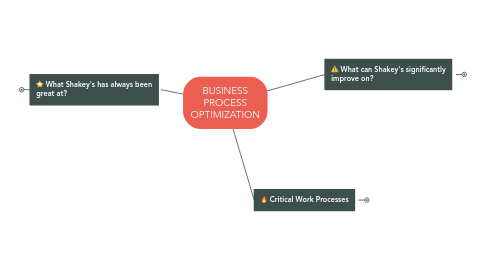
1. What Shakey's has always been great at?
1.1. Product Management
1.1.1. Core Departments
1.1.1.1. Marketing
1.1.1.2. R&D
1.1.2. Strengths
1.1.2.1. Availability and profitability of products
1.1.2.2. Creative and High Value perception for new products
1.1.3. Direct Beneficiary / ies of Improvement
1.1.3.1. Guests/Business Units/ Brand Marketing
1.2. Training and Development
1.2.1. Core Departments
1.2.1.1. Training/HR
1.2.2. Strengths
1.2.2.1. Resourcefulness for new concepts and ability to customize for in-house cascading
1.2.3. Direct Beneficiary / ies of Improvement
1.2.3.1. Business Units/Corporate Office
1.3. Product Development (new and re-engineering))
1.3.1. Core Departments
1.3.1.1. Marketing (Research and Development)
1.3.2. Strengths
1.3.2.1. Positive market acceptance of new products, and Timely development of new products
1.3.3. Direct Beneficiary / ies of Improvement
1.3.3.1. Guests
2. What can Shakey's significantly improve on?
2.1. Data Management
2.1.1. Core Department / s
2.1.1.1. IT and HR
2.1.2. Business Concern / s
2.1.2.1. Accurate data and reports, and Better systems interface
2.1.2.2. PUSH capability to Users
2.1.2.3. Invest in developing a data centric culture (people and infrastructure)
2.1.2.4. Application systems are built to solve problems. Consider also readiness of data structure to be used for business intelligence and data science.
2.1.3. Direct Beneficiary / ies of Improvement
2.1.3.1. All
2.2. Manpower Planning (Identification of placement)
2.2.1. Core Department / s
2.2.1.1. HR (and all)
2.2.2. Business Concern / s
2.2.2.1. Long-range planning and budgeting, and Quality of RMs and ABMs
2.2.3. Direct Beneficiary / ies of Improvement
2.2.3.1. All
2.3. Financial Processes
2.3.1. Core Department / s
2.3.1.1. Finance
2.3.2. Business Concern / s
2.3.2.1. Business Operations accounting and monitoring.
2.3.2.2. Too Finance-centric and not Internal Guest Centric
2.3.3. Direct Beneficiary / ies of Improvement
2.3.3.1. All
2.4. Project Management (Construction)
2.4.1. Core Department / s
2.4.1.1. TSD
2.4.2. Business Concern / s
2.4.2.1. Project planning and governance
2.4.2.2. Increasing costs/ Decreasing Quality
2.4.3. Direct Beneficiary / ies of Improvement
2.4.3.1. All
2.5. Vendor Management
2.5.1. Core Department / s
2.5.1.1. MMD
2.5.2. Business Concern / s
2.5.2.1. Vendor accreditation and evaluation
2.5.3. Direct Beneficiary / ies of Improvement
2.5.3.1. All
2.6. Project Management (WIGs)
2.6.1. Core Department / s
2.6.1.1. All
2.6.2. Business Concern / s
2.6.2.1. Adequate planning and coordination, and Progress Reporting
2.6.3. Direct Beneficiary / ies of Improvement
2.6.3.1. All
2.7. Marketing Calendar
2.7.1. Core Department / s
2.7.1.1. Marketing
2.7.2. Business Concern / s
2.7.2.1. Monthly Baseline targets in absolute terms per BU/Channel/
2.7.3. Direct Beneficiary / ies of Improvement
2.7.3.1. All
2.8. Marketing Communication
2.8.1. Core Department / s
2.8.1.1. Marketing
2.8.2. Business Concern / s
2.8.2.1. Brand reach and retention
2.8.3. Direct Beneficiary / ies of Improvement
2.8.3.1. All
2.9. Marketing Campaigns
2.9.1. Core Department / s
2.9.1.1. Marketing
2.9.2. Business Concern / s
2.9.2.1. Late deployment of campaigns
2.9.3. Direct Beneficiary / ies of Improvement
2.9.3.1. Business Units
2.10. Training and Development
2.10.1. Core Department / s
2.10.1.1. HR and Learning and Development
2.10.2. Business Concern / s
2.10.2.1. Strong organizational development (functional assignments), and Training quality (Centralized and standard)
2.10.3. Direct Beneficiary / ies of Improvement
2.10.3.1. All
2.11. Internal Controls
2.11.1. Core Department / s
2.11.1.1. All
2.11.2. Recommendation / s
2.11.2.1. Strengthening of lines of defense across the board.
2.11.2.2. Documentation and implementation of standards for projects, requirements, policies, guidelines, etc.
2.11.2.3. Strengthening / adding flexibility on promo controls in sales generating systems (POS, SDS, and Online Ordering)
2.11.3. Direct Beneficiary / ies of Improvement
2.11.3.1. All
2.12. New Store Openings
2.12.1. Core Department / s
2.12.1.1. Business Development
2.12.2. Recommendation / s
2.12.2.1. Delayed Openings/ Low Sales
2.12.3. Direct Beneficiary / ies of Improvement
2.12.3.1. Business Units
2.13. Store Operations
2.13.1. Core Department / s
2.13.1.1. Business Units
2.13.2. Recommendation / s
2.13.2.1. Inconsistent QSCH Compliance
2.13.3. Direct Beneficiary / ies of Improvement
2.13.3.1. Business Units/ Brand Image
3. Critical Work Processes
3.1. Project Management (WIGS)
3.1.1. Core Department / s
3.1.1.1. Majority
3.1.2. Area of Concern
3.1.2.1. WIGS ; only in paper
3.1.3. Direct Beneficiary of Improvement
3.1.3.1. All
3.2. Project Management (Construction)
3.2.1. Core Department / s
3.2.1.1. TSD/RBU/BD/FINANCE
3.2.2. Area of Concern
3.2.2.1. New Store Opening/Costing
3.2.3. Direct Beneficiary of Improvement
3.2.3.1. RBUs
3.3. Project Management (Application Systems)
3.3.1. Core Department / s
3.3.1.1. BU, IT,
3.3.2. Area of Concern
3.3.2.1. System Process
3.3.3. Direct Beneficiary of Improvement
3.3.3.1. For all department
3.4. Data Management
3.4.1. Core Department / s
3.4.1.1. IT
3.4.2. Area of Concern
3.4.2.1. Accessibility: Integrity: Timeliness
3.4.2.2. Ease of Using and Accuracy
3.4.2.3. Extraction
3.4.3. Direct Beneficiary of Improvement
3.4.3.1. All operating units
3.5. Training and Development (OPS)
3.5.1. Core Department / s
3.5.1.1. Actual Execution
3.5.2. Area of Concern
3.5.2.1. Actual Execution
3.5.3. Direct Beneficiary of Improvement
3.5.3.1. BU
3.6. Performance Management
3.6.1. Core Department / s
3.6.1.1. HR/Executive
3.6.2. Area of Concern / Improvement
3.6.2.1. Performance Monitoring
3.6.2.2. Performance Correction
3.6.2.3. Performance Improvement Plan
3.6.3. Direct Beneficiary of Improvement
3.6.3.1. All
3.7. Store Operations
3.7.1. Core Department / s
3.7.1.1. Business Units
3.7.2. Area of Concern / Improvement
3.7.2.1. QSCH Execution
3.7.2.2. Costs Improvement
3.7.2.3. Franchisee Compliance
3.7.3. Direct Beneficiary of Improvement
3.7.3.1. The Whole Organization
3.8. Project Management (Construction/IT/MMD)
3.8.1. Core Department / s
3.8.1.1. TSD/IT/MMD
3.8.2. Area of Concern / Improvement
3.8.2.1. Rising costs of projects
3.8.2.2. Availability of competent suppliers
3.8.2.3. Slow implementation
3.8.3. Direct Beneficiary of Improvement
3.8.3.1. Business Units
